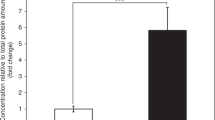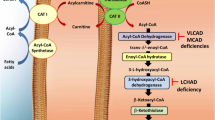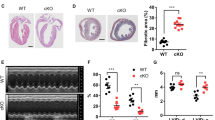Abstract
Patients with inborn errors of long-chain fatty acid oxidation accumulate disease-specific acylcarnitines and triacylglycerols in various tissues. Some of these patients present significant cardiac diseases such as arrhythmias and cardiomyopathy. The mechanism of how fatty acid accumulation is involved in disease pathogenesis is still unclear but apoptosis of cardiomyocytes has been suggested to be one possible mechanism of cardiomyopathy development. In this study, we measured lipid uptake and intracellular lipid accumulation after incubation of HL1 cardiomyocytes with different saturated and monounsaturated long- and medium-chain fatty acid species for various time periods and at different physiological concentrations. We assessed apoptosis induction by analyzing the mitochondrial membrane potential and TLR-4 expression as well as the composition of the accumulating triacylglycerols. We identified only 14:1 and 16:1 monounsaturated fatty acids potentially leading to an increase in TLR-4 expression and disruption of the mitochondrial membrane potential, resulting in apoptosis and necrosis in cultured cardiomyocytes. This study demonstrates significant toxicity of especially those fatty acid species in vitro that significantly accumulate in fatty acid oxidation defects presenting with cardiac disease such as very long-chain acyl-CoA dehydrogenase, carnitine acylcarnitine translocase and carnitine palmitoyl-CoA transferase deficiencies.










Similar content being viewed by others
Abbreviations
- CACT:
-
Carnitine/acylcarnitine translocase
- CDDE:
-
Cell death detection ELISA
- ELISA:
-
Enzyme linked immunosorbent assay
- FACS:
-
Fluorescence activated cell sorting
- FCS:
-
Fetal calf serum
- FFA:
-
Free fatty acid(s)
- HMGB:
-
High mobility group binding protein
- LDH:
-
Lactate dehydrogenase
- MMP:
-
Mitochondrial membrane potential
- MCAD:
-
Medium-chain-acyl-CoA-dehydrogenase
- mRNA:
-
Messenger ribonucleic acid
- PBS:
-
Phosphate buffered saline
- PCR:
-
Polymerase chain reaction
- PGC-1α:
-
Peroxisome proliferator activated receptor-gamma coactivator 1 alpha
- PPAR-α:
-
Peroxisome proliferator activated receptor-alpha
- PDK4:
-
Pyruvate dehydrogenase kinase 4
- TLR-4:
-
Toll-like receptor 4
- UPLC-MS/MS:
-
Ultra pressure liquid chromatography tandem mass spectrometry
- VLCAD:
-
Very long-chain-acyl-CoA-dehydrogenase
References
Gregersen N, Bross P, Andresen BS (2004) Genetic defects in fatty acid beta-oxidation and acyl-CoA dehydrogenases. Molecular pathogenesis and genotype-phenotype relationships. Eur J Biochem 271:470–482
Bonnet D, Martin D, De Pascale L, Villain E, Jouvet P, Rabier D, Brivet M, Saudubray JM (1999) Arrhythmias and conduction defects as presenting symptoms of fatty acid oxidation disorders in children. Circulation 100:2248–2253
Choong K, Clarke JT, Cutz E, Pollit RJ, Olpin SE (2001) Lethal cardiac tachyarrhythmia in a patient with neonatal carnitine-acylcarnitine translocase deficiency. Pediatr Dev Pathol 4:573–579
Roe CR, Sweetman L, Roe DS, David F, Brunengraber H (2002) Treatment of cardiomyopathy and rhabdomyolysis in long-chain fat oxidation disorders using an anaplerotic odd-chain triglyceride. J Clin Invest 110:259–269
Iguchi K, Okumura N, Usui S, Sajiki H, Hirota K, Hirano K (2001) Myristoleic acid, a cytotoxic component in the extract from Serenoa repens, induces apoptosis and necrosis in human prostatic LNCaP cells. Prostate 47:59–65
Lee JY, Sohn KH, Rhee SH, Hwang D (2001) Saturated fatty acids, but not unsaturated fatty acids, induce the expression of cyclooxygenase-2 mediated through toll-like receptor 4. J Biol Chem 276:16683–16689
Claycomb WC, Lanson NA Jr, Stallworth BS, Egeland DB, Delcarpio JB, Bahinski A, Izzo NJ Jr (1998) HL-1 cells: a cardiac muscle cell line that contracts and retains phenotypic characteristics of the adult cardiomyocyte. Proc Natl Acad Sci U S A 95:2979–2984
Akazawa Y, Cazanave S, Mott JL, Elmi N, Bronk SF, Kohno S, Charlton MR, Gores GJ (2010) Palmitoleate attenuates palmitate-induced bim and PUMA up-regulation and hepatocyte lipoapoptosis. J Hepatol 52:586–593
Cazanave SC, Elmi NA, Akazawa Y, Bronk SF, Mott JL, Gores GJ (2010) CHOP and AP-1 cooperatively mediate PUMA expression during lipoapoptosis. Am J Physiol Gastrointest Liver Physiol 299:G236–G243
Cazanave SC, Mott JL, Elmi NA, Bronk SF, Masuoka HC, Charlton MR, Gores GJ (2011) A role for miR-296 in the regulation of lipoapoptosis by targeting PUMA. J Lipid Res 52:1517–1525
Cazanave SC, Mott JL, Elmi NA, Bronk SF, Werneburg NW, Akazawa Y, Kahraman A, Garrison SP, Zambetti GP, Charlton MR, Gores GJ (2009) JNK1-dependent PUMA expression contributes to hepatocyte lipoapoptosis. J Biol Chem 284:26591–26602
Richieri GV, Kleinfeld AM (1995) Unbound free fatty acid levels in human serum. J Lipid Res 36:229–240
Belfort R, Harrison SA, Brown K, Darland C, Finch J, Hardies J, Balas B, Gastaldelli A, Tio F, Pulcini J, Berria R, Ma JZ, Dwivedi S, Havranek R, Fincke C, DeFronzo R, Bannayan GA, Schenker S, Cusi K (2006) A placebo-controlled trial of pioglitazone in subjects with nonalcoholic steatohepatitis. N Engl J Med 355:2297–2307
Sanyal AJ, Campbell-Sargent C, Mirshahi F, Rizzo WB, Contos MJ, Sterling RK, Luketic VA, Shiffman ML, Clore JN (2001) Nonalcoholic steatohepatitis: association of insulin resistance and mitochondrial abnormalities. Gastroenterology 120:1183–1192
Ruiz-Meana M, Inserte J, Fernandez-Sanz C, Hernando V, Miro-Casas E, Barba I, Garcia-Dorado D (2011) The role of mitochondrial permeability transition in reperfusion-induced cardiomyocyte death depends on the duration of ischemia. Basic Res Cardiol 106:1259–1268
Schafer C, Hoffmann L, Heldt K, Lornejad-Schafer MR, Brauers G, Gehrmann T, Garrow TA, Haussinger D, Mayatepek E, Schwahn BC, Schliess F (2007) Osmotic regulation of betaine homocysteine-S-methyltransferase expression in H4IIE rat hepatoma cells. Am J Physiol Gastrointest Liver Physiol 292:G1089–G1098
Tenenbaum T, Essmann F, Adam R, Seibt A, Janicke RU, Novotny GE, Galla HJ, Schroten H (2006) Cell death, caspase activation, and HMGB1 release of porcine choroid plexus epithelial cells during Streptococcus suis infection in vitro. Brain Res 1100:1–12
Erlandsson Harris H, Andersson U (2004) Mini-review: the nuclear protein HMGB1 as a proinflammatory mediator. Eur J Immunol 34:1503–1512
Scaffidi P, Misteli T, Bianchi ME (2002) Release of chromatin protein HMGB1 by necrotic cells triggers inflammation. Nature 418:191–195
Finck BN, Kelly DP (2007) Peroxisome proliferator-activated receptor gamma coactivator-1 (PGC-1) regulatory cascade in cardiac physiology and disease. Circulation 115:2540–2548
Liang H, Ward WF (2006) PGC-1alpha: a key regulator of energy metabolism. Adv Physiol Educ 30:145–151
Madrazo JA, Kelly DP (2008) The PPAR trio: regulators of myocardial energy metabolism in health and disease. J Mol Cell Cardiol 44:968–975
Watanabe K, Fujii H, Takahashi T, Kodama M, Aizawa Y, Ohta Y, Ono T, Hasegawa G, Naito M, Nakajima T, Kamijo Y, Gonzalez FJ, Aoyama T (2000) Constitutive regulation of cardiac fatty acid metabolism through peroxisome proliferator-activated receptor alpha associated with age-dependent cardiac toxicity. J Biol Chem 275:22293–22299
Rubio-Gozalbo ME, Bakker JA, Waterham HR, Wanders RJ (2004) Carnitine-acylcarnitine translocase deficiency, clinical, biochemical and genetic aspects. Mol Aspects Med 25:521–532
Kong JY, Rabkin SW (2000) Palmitate-induced apoptosis in cardiomyocytes is mediated through alterations in mitochondria: prevention by cyclosporin A. Biochim Biophys Acta 1485:45–55
Obeid LM, Linardic CM, Karolak LA, Hannun YA (1993) Programmed cell death induced by ceramide. Science 259:1769–1771
Kong JY, Rabkin SW (2002) Palmitate-induced cardiac apoptosis is mediated through CPT-1 but not influenced by glucose and insulin. Am J Physiol Heart Circ Physiol 282:H717–H725
Hue L, Taegtmeyer H (2009) The Randle cycle revisited: a new head for an old hat. Am J Physiol Endocrinol Metab 297:E578–E591
Odle J (1997) New insights into the utilization of medium-chain triglycerides by the neonate: observations from a piglet model. J Nutr 127:1061–1067
Chegary M, Brinke H, Ruiter JP, Wijburg FA, Stoll MS, Minkler PE, van Weeghel M, Schulz H, Hoppel CL, Wanders RJ, Houten SM (2009) Mitochondrial long chain fatty acid beta-oxidation in man and mouse. Biochim Biophys Acta 1791:806–815
Acknowledgments
The study was supported by grants from the Deutsche Forschungsgemeinschaft (SFB 575 and SFB 612 Heinrich Heine University Duesseldorf).
Conflict of interest
Nothing to disclose.
Author information
Authors and Affiliations
Corresponding author
About this article
Cite this article
Hoffmann, L., Seibt, A., Herebian, D. et al. Monounsaturated 14:1n-9 and 16:1n-9 Fatty Acids but not 18:1n-9 Induce Apoptosis and Necrosis in Murine HL-1 Cardiomyocytes. Lipids 49, 25–37 (2014). https://doi.org/10.1007/s11745-013-3865-4
Received:
Accepted:
Published:
Issue Date:
DOI: https://doi.org/10.1007/s11745-013-3865-4




